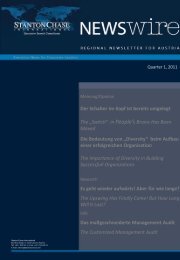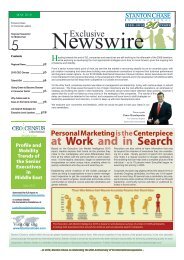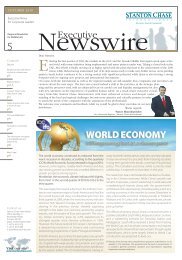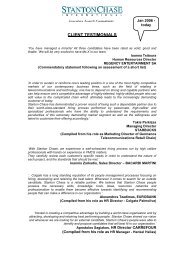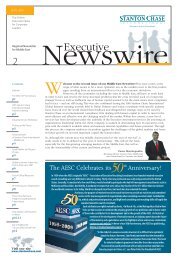Management Audit with Stanton Chase's Executive Assess ...
Management Audit with Stanton Chase's Executive Assess ...
Management Audit with Stanton Chase's Executive Assess ...
Create successful ePaper yourself
Turn your PDF publications into a flip-book with our unique Google optimized e-Paper software.
STANTON CHASE INTERNATIONAL<br />
By Emerson Hughes<br />
Managing Director<br />
<strong>Stanton</strong> Chase<br />
Montreal<br />
...we researched the<br />
reasons why<br />
employees leave.<br />
We learned that<br />
there are 10 primary<br />
resignation<br />
motivators...<br />
3 are recruiting and<br />
selection related,<br />
and<br />
4 are essentially<br />
disconnects or<br />
failures in<br />
communication.<br />
www.stantonchase.com<br />
Get It Right And Keep It Right:<br />
Retention Starts With Recruiting<br />
Hiring the right employees and retaining key employees are fundamental HR practices. Search firms<br />
that truly partner <strong>with</strong> their clients participate fully in both practices. We have partnered <strong>with</strong> clients<br />
on both fronts for years, long before retention became a hot topic. Now retention is a preoccupation<br />
as the war for talent heats up.<br />
We have always believed that providing a service that supports and enhances retention delivers<br />
additional value to our clients, rendering our core service-recruitment-more cost-effective, and<br />
strengthening our relationship <strong>with</strong> our client at the same time.<br />
Many years ago we researched the reasons why employees leave. We learned that there are 10<br />
primary resignation motivators, and recent research indicates that those motivators are still at play.<br />
We analyzed the motivators and determined that we could directly influence 7 of them; 3 are recruiting<br />
and selection related, and 4 are essentially disconnects or failures in communication. So, we developed<br />
recruiting and communications protocols to address the motivators in an attempt to obviate<br />
resignations. These protocols are embedded in everything we do, starting <strong>with</strong> the first meeting<br />
<strong>with</strong> a client to get job specs. We have found them to be effective, as, sadly, many companies are<br />
resistant to change. They are not doing everything that could be done to retain their employees and,<br />
as a result, they are watching their talent walk out the door.<br />
Let's look at the most common reasons employees leave and what external recruiters can do to<br />
improve the retention of the employees they recruit for their clients.<br />
1. The job or workplace was not as expected. This<br />
can be addressed during the recruiting and<br />
selection process. Recruiters need to present a<br />
clear and accurate description of the job, the<br />
performance expectations, the supervisor's<br />
management style, weaknesses and strengths,<br />
the corporate culture and values. The corporate<br />
company and the candidate going into a new<br />
job should be fully informed.<br />
2. Poor fit. There is a mismatch between the job<br />
and the hire, or the hire and the supervisor. This,<br />
too, can be addressed during the recruiting and<br />
selection process. The assessment process should<br />
be rigorous. Drill down; then, drill down again.<br />
3. There are too few growth and advancement<br />
opportunities. Again, this is an issue that can be<br />
addressed during the recruiting and selection<br />
process. Recruiters should ensure that there will<br />
be enough of a career runway for the candidate's<br />
ambitions. The recruiter should understand the<br />
candidate's career objectives and carefully assess<br />
motivations.<br />
4. Once on the job, there is too little coaching and<br />
feedback, or all too frequently, none at all. This is<br />
a communication and management problem.<br />
External recruiters can facilitate, and sometimes<br />
orchestrate, communications between a manager<br />
and employee. We communicate regularly <strong>with</strong><br />
our hires, and when appropriate, we convene<br />
meetings and include the human resources<br />
department. The key is that we are proactive.<br />
5. The employee feels devalued and unrecognized.<br />
This, too, is a communications and management<br />
problem. Again, we are proactive and facilitate<br />
communication between the manager and<br />
employee. Recognition is one of the most effective<br />
ways to retain and motivate your employees.<br />
A well-designed recognition program can have<br />
a significant impact on employee loyalty and also<br />
influence behaviours, attitudes, values, customer<br />
satisfaction, process improvements, time to<br />
market; quality-the list is potentially endless, and<br />
unique to every company. The point is, people<br />
respond to recognition and appreciation.<br />
6. The employee is stressed from overwork and<br />
a work-life imbalance. This is frequently a<br />
communication problem, and it is usually<br />
solvable. The key is to acknowledge the<br />
conditions and not permit them to persist<br />
<strong>with</strong>out attempting to relieve the pressure, even<br />
temporarily. Without relief, the pressure will build<br />
and lead to a resignation.<br />
7. There is a loss of trust and confidence in senior<br />
leaders. This is frequently a communication<br />
problem. Leaders who don't communicate or<br />
communicate ineffectively are often unaware of<br />
the problem. We encourage our hires to<br />
precipitate communication <strong>with</strong> their manager,<br />
to ask questions, to get informed, to network in<br />
the company and to reach out to the human<br />
resources department.<br />
4




